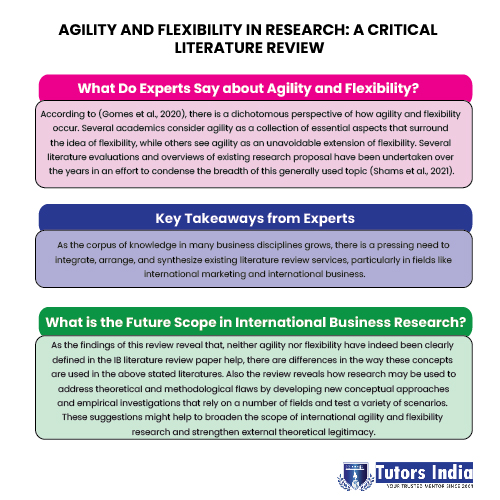Agility and Flexibility in Research: A Critical Literature Review
Organizations in today’s dynamic and highly competitive market require a diverse mix of talents to respond effectively and efficiently to growing levels of uncertainty, complexity, and unpredictability. These reactions have been linked to the concepts of agility and flexibility in both study and practise, since the terms are used interchangeably in the literature to describe a comparable occurrence. The impression of ‘speed,’ or ‘quickness,’ is also included in the term agility (Christofi et al., 2021).
In addition, the current body of information on agility and flexibility has demonstrated that IB research is increasingly focused on the topic. Surprisingly, despite a slew of articles in IB journals on the subject, the structure, scope, and complexity of agility and flexibility research in IB is still largely unexplored. Several literature evaluations and overviews of existing research proposal have been undertaken over the years in an effort to condense the breadth of this generally used topic (Shams et al., 2021).
What Do Experts Say about Agility and Flexibility?
According to (Gomes et al., 2020), there is a dichotomous perspective of how agility and flexibility occur. Several academics consider agility as a collection of essential aspects that surround the idea of flexibility, while others see agility as an unavoidable extension of flexibility. Furthermore, agility and flexibility are wide yet interconnected ideas with different meanings in different fields. Production and operation management, for example, is concerned with an organization’s flexible activities, workflows, and supply chain links. Authors have to do review with effectively and successfully adjusting to ever-changing and unpredictable situations in the field of corporate strategy. They suggested organizations in dealing with new components of global competition, among other things in the IB arena. Academic interest in speed and flexibility has been steadily increasing, with attention coming from a variety of academic fields such as management and decision – making.
Researchers Asseraf et al. (2018) have improved the understanding of agility and adaptability across a variety of disciplines, including information systems, supply chain management, management of human resources, and general management. To the knowledge, no previous study has examined studies on agility and flexibility in the IB area in a systematic and through manner (Benzidia & Makaoui, 2020). Furthermore, as the corpus of knowledge in many business disciplines grows, there is a pressing need to integrate, arrange, and synthesize existing literature review services, particularly in fields like international marketing and international business.
Another gap, and hence future study area, arises from the different definitional challenges that exist in the IB field with the notions of agility and flexibility. The existing IB research on agility and flexibility, in particular, appears to be rather comprehensive, outlining a range of definitions of the terms and embedding them in a wide range of formats, meanings, and theoretical framings to fulfill a variety of purposes (Patel & Sambasivan, 2022).
According to Khan (2020), convenience and a wide variety of definitions, on the other hand, might cause confusion, which has been noted in other disciplines such as strategy, operations, and supply chain management. Furthermore, misunderstanding arises as a result of the interchangeable usage of the phrases agility and flexibility to represent the same set of events or scenarios. However, as previously said, one important distinction between the two concepts is that agility stresses a firm’s capacity to respond quickly to problems or changes (Shukor et al., 2020).

Key Takeaways from Experts
- Agility as a collection of essential aspects that surround the idea of flexibility, while others see agility as an unavoidable extension of flexibility.
- Agility and flexibility are wide yet interconnected ideas with different meanings in different fields.
- As the corpus of knowledge in many business disciplines grows, there is a pressing need to integrate, arrange, and synthesize existing literature review services, particularly in fields like international marketing and international business.
- One important distinction between the two concepts is that agility stresses a firm’s capacity to respond quickly to problems or changes.
What is the Future Scope in International Business Research?
As the findings of this review reveal that, neither agility nor flexibility have indeed been clearly defined in the IB literature review paper help, there are differences in the way these concepts are used in the above stated literatures. In a scientific discipline, a lack of definitional clarity and a set of standard definitions and definitional dimensions might cause academic results to be delayed in reaching commercial realities, and IB is not exempt.
Also the review reveals how research may be used to address theoretical and methodological flaws by developing new conceptual approaches and empirical investigations that rely on a number of fields and test a variety of scenarios. These suggestions might help to broaden the scope of international agility and flexibility research and strengthen external theoretical legitimacy.
According to the conclusions of this review, the condition currently exists throughout the scope of IB literature. Numerous definition-related reviews of literature and conceptual research exist in different fields in an effort to find solutions to similar definitional difficulties. This blog has suggested and developed pathways for future research to solve knowledge gaps in the area by adding exciting theoretical contributions.
We hope that this blog will serve as a springboard for new and interesting research on a variety of worldwide agility and flexibility patterns that will be of interest to a wide range of practitioners and academics in International Business Research.
References
- Asseraf, Y., Lages, L. F., & Shoham, A. (2018). Assessing the drivers and impact of international marketing agility. International Marketing Review. https://www.emerald.com/insight/content/doi/10.1108/IMR-12-2017-0267/full/html
- Benzidia, S., & Makaoui, N. (2020). Improving SMEs performance through supply chain flexibility and market agility: IT orchestration perspective. Supply Chain Forum: An International Journal, 21(3), 173–184. https://doi.org/10.1080/16258312.2020.1801108
- Christofi, M., Pereira, V., Vrontis, D., Tarba, S., & Thrassou, A. (2021). Agility and flexibility in international business research: A comprehensive review and future research directions. Journal of World Business, 56(3), 101194. https://doi.org/10.1016/j.jwb.2021.101194
- Khan, H. (2020). Is marketing agility important for emerging market firms in advanced markets? International Business Review, 29(5), 101733. https://doi.org/10.1016/j.ibusrev.2020.101733
- Patel, B. S., & Sambasivan, M. (2022). A systematic review of the literature on supply chain agility. Management Research Review, 45(2), 236–260. https://doi.org/10.1108/MRR-09-2020-0574
- Shams, R., Vrontis, D., Belyaeva, Z., Ferraris, A., & Czinkota, M. R. (2021). Strategic agility in international business: A conceptual framework for “agile” multinationals. Journal of International Management, 27(1), 100737. https://doi.org/10.1016/j.intman.2020.100737
- Shukor, A. A. A., Newaz, M. S., Rahman, M. K., & Taha, A. Z. (2020). Supply chain integration and its impact on supply chain agility and organizational flexibility in manufacturing firms. International Journal of Emerging Markets. https://www.emerald.com/insight/content/doi/10.1108/IJOEM-04-2020-0418/full/html

 Previous Post
Previous Post Next Post
Next Post